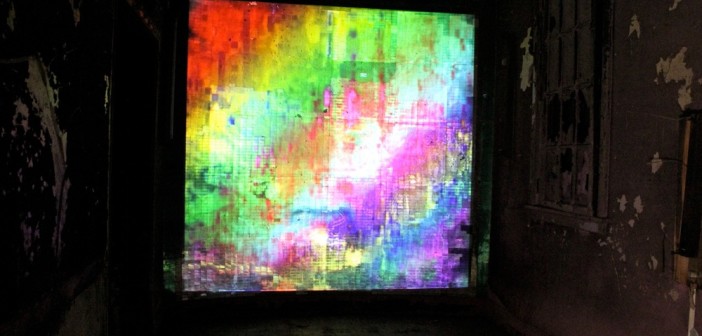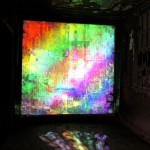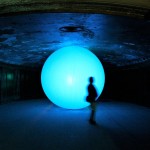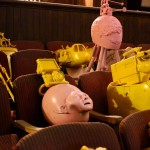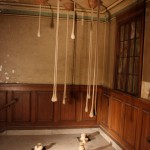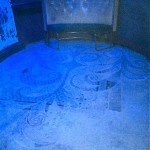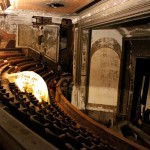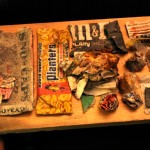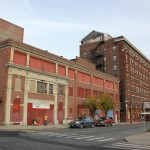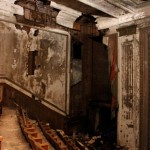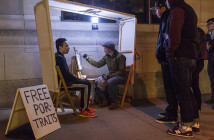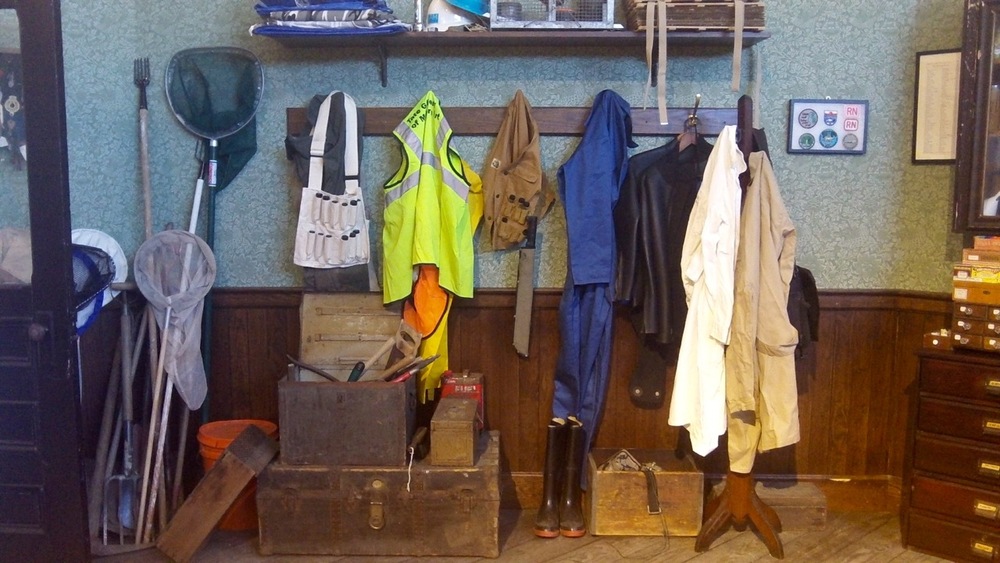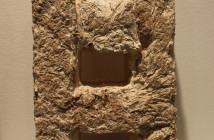So it is apropos that the Massachusetts International Festival of the Arts (MIFA) decided to let some artists loose inside the soon-to-be-renovated Victory Theatre before it gets all gussied up for its first show in decades. Most of the artists in the exhibition "In The Round" live and/or work in Holyoke. This is their town, their community, and their reality. They, better than anyone else, tap into the ethos, nay the pathos, of this crumbling historic beauty, and in doing so, may well have served up a bittersweet metaphor for the change that’s going on throughout Holyoke.
My first thought as I walk into the Victory Theatre is that I should have worn a respirator and probably a haz-mat suit. After thirty plus years of neglect the New England weather had done a Matta-Clark job on the roof and opened the lot of it up to the elements. Rain had promulgated spores, peeled paint, warped veneer, molded fabric and brought much of the plaster filigree crumbling to the floor. Undaunted, despite my hypochondria, I venture further in.
Passing time in a mirrored room just of the main foyer, Kari Gatzke’s video projection, "Lavatory Waiting Room" channels the Victory’s history as an old movie house. Using altered footage of the room itself, Gatzke’s painterly wall sized piece glows with a spectral aura that conjures up the ghosts of projections gone bye. It is a slow burner, and what seems at first to be digital pixelation reveals itself as the grid left from the small, mirrored tiles that once covered the wall. Some of these tiles still remain and re-project the video back into the room, fractured onto my shoes, cleverly calling into question the one thing you are supposed to sneak in to the theater with you: your willing suspension of disbelief.
Upstairs, I come across a giant luminous blue orb in the center of an oval room. As I draw closer the sphere of light looms over me, and I see that it fills the height of the room although it throws off my depth perception. Instinctively I reach out my hand. When I touch the orb a sound echoes around me. Other folks are doing the same to what turns out to be a weather balloon lit from within that uses sensors to amplify the sounds in the room. Visually, Chris Nelson’s "Touching the Void" is reminiscent of a Robert Irwin or James Turrell, but without any sort of visual proscenium. The viewer is meant to interact with the work, as when an actor speaks directly to the audience, breaking the so-called "fourth wall" of the stage. Nelson’s "Void" in fact fills the space by spotlighting the architecture and the echoes of its audience and creating a shared experience, "in the round."
Meanwhile, downstairs in the theatre an audience clad in yellow and pink has made themselves at home in front of a video monitor. This audience, the work of Torsten Zenas Burns consists of outdated technology, motorcycle (space?) helmets, toys, and other semi-identifiable plastic objects. These so called "Yellow Mobilers" have the appearance of theater props but allude to some other totemic purpose. Used in a video series that Burns calls "Demoformances"(my boss is an artist, but for some this link might be NSFW) these objects with their brightly colored, often textured coatings reference a bodily utility. As presented in the theatre they are ripe with performance residue, like an audience in the afterglow of the curtain call as they prepare to depart for other worlds.
There are six other artists in the exhibition as well, whose work responds to the current state of this old building. Christopher Willingham’s pendulously fecund piece, "Le Langue des Fleurs" seems to have spawned itself straight from the damp of the rotting timbers. In the aptly named, "Powder Room" Amy Johnquest carefully and subtly repeats the vintage wallpaper’s floral designs in the thick dust on the women’s room floor. Unfortunately, this piece was partly scattered by a visitor’s errant steps. How poetic though? Dust to dust, and all that. Angela Zammarelli and Joshua Vrysen present all the 1970’s concession stand offerings they found under the balcony seats. In the end however, I feel like Gatzke, Nelson, and Burns really took the ouija board to this place, exorcising the essence of its theatrical birth, death and future rebirth.
Outside the brick and boarded façade I chat about that future with Don Saunders, Executive Artistic Director of MIFA. He tells me that they are approximately 3 years and 7 million dollars away from realizing the 28 million dollar renovation project that has been 10 years in the making. MIFA’s vision for the Victory Theatre is to reclaim its glorious past and make Holyoke a destination for world-class performances. This vision includes a gallery for visual art, and a strong commitment to mixed programming and interdisciplinary dialogue. Speaking of mixed programming, the Whitney Biennial comes up, we talk about performance in the gallery, art in the theatre, and Saunders says, "It’s not the building, it’s what you put in it, that makes it great." I like that.
So Holyoke, with 23 year-old, mayor Alex Morse at the helm, has a much-needed infusion of new energy and fresh ideas. The city is already building a new "green" high-performance computing center, backed by Harvard, MIT, BU, Northeastern and UMASS Universities. Holyoke has shunned the casinos, and made for the knowledge corridor. With the infrastructure of a planned industrial community to support sustainable re growth (think of Holyoke’s canals providing hydro-powered work spaces), the Victory project seems like a well-timed slam dunk.
Besides the threat of a Starbucks around the corner, what does all this potential re-growth actually mean for Holyoke’s artists? Can a renovated theatre signal the impending collapse of an artist’s utopia, with higher rents, increased costs of living, less space for more money, no more live/work lofts? Will Holyoke’s artists be priced out of the community they have helped to rebuild?
Chris Nelson, who is also the curator of the exhibition at the Victory, offered me a clue, "I chose artists who I knew could work under these conditions: musty, dusty, moldy, no working toilet, limited light and hardly any power".
To the pioneers go the Victory’s spoils.
Living the artist’s dream (for now) in Holyoke, MA.
- Kari Gatzke, Lavatory Waiting Room
- Chris Nelson, Touching the Void
- Torsten Zenas Burns, Demoformance (Audience)
- Christopher Willingham, Les Langue des Fleurs
- Amy Johnquest, Powder Room. Photo Credit Amy Johnquest
- Detail, Angela Zammarelli and Joshua Vrysen, We Could Live Here “Rope Pathetic”
- Exterior view of the Victory Theatre
- A gaping hole
The Massachusetts International Festival of the Arts presents: "In The Round" a site-specific installation exhibition at the Victory Theatre. Through November 18th, Appointments can be arranged by calling Chris Nelson at (413) 297-0786.
Exhibition Artists: Olivia Bernard, Torsten Zenas Burns, Taiga Ermansons, Kari Gatzke, Amy Johnquest, Chris Nelson, Joshua Vrysen, Christopher and Angela Zammarelli
All images are courtesy of Samuel Rowlett except where noted.

